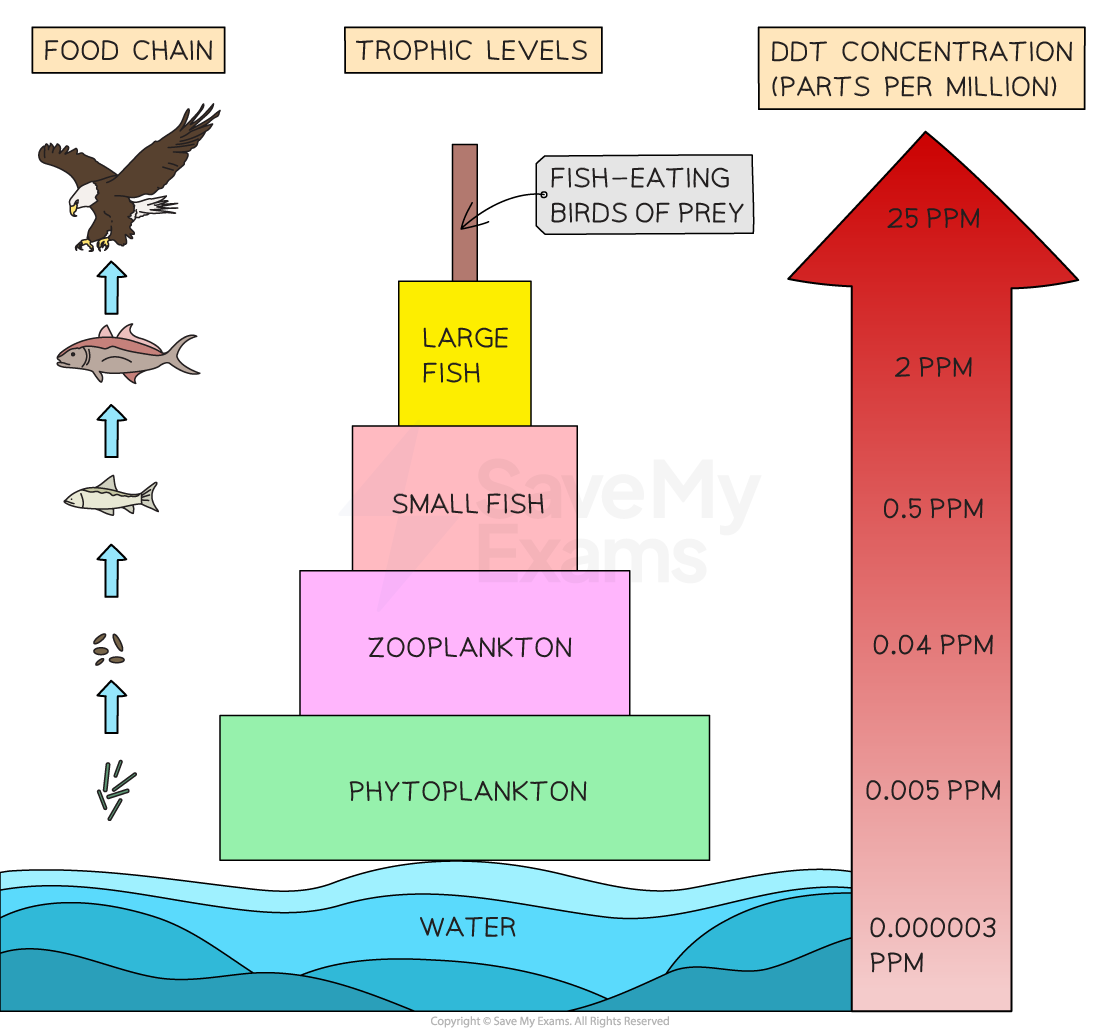Human Impacts on Energy & Matter Flows (HL IB Environmental Systems & Societies (ESS))
Revision Note

Author
Alistair MarjotExpertise
Biology & Environmental Systems and Societies
Human Impacts on Energy & Matter Flows
Bioaccumulation and biomagnification
Bioaccumulation is the build-up of persistent or non-biodegradable pollutants within an organism or trophic level because they cannot be broken down
Biomagnification is the increase in the concentration of persistent or non-biodegradable pollutants along a food chain
As pollutants are passed up the food chain from one trophic level to the next, they become more concentrated
This means that organisms at higher trophic levels (such as top predators) accumulate higher concentrations of pollutants than those at lower trophic levels
This is due to the decrease in the total biodegradable biomass of organisms at higher trophic levels
Pollutants that are persistent and non-biodegradable can accumulate along food chains
Examples include:
Polychlorinated biphenyl (PCB)
Dichlorodiphenyltrichloroethane (DDT)
Mercury
They can cause changes to ecosystems through the processes of bioaccumulation and biomagnification
For example, DDT was a widely used insecticide in the mid-20th century that was found to have harmful effects on birds of prey such as eagles and falcons
When DDT was sprayed on crops, it would leach into waterways and eventually enter freshwater and marine ecosystems
DDT would then enter food chains (via plankton) and accumulate in the bodies of fish
These fish would then be eaten by birds, which would accumulate higher concentrations of DDT
Because DDT is persistent and does not break down easily, it can continue to accumulate in the bodies of animals at higher trophic levels (such as birds of prey), leading to harmful effects such as thinning of eggshells and reduced reproductive success

Mercury is another example of a pollutant that can accumulate along food chains
Mercury is released into the environment through activities such as coal-fired power plants and gold mining
Once in the environment, mercury can be converted into a highly toxic form called methylmercury
This accumulates in the bodies of fish
As larger fish eat smaller fish, the concentration of methylmercury within the tissues of these fish increases, leading to potential harm for humans who eat large predatory fish such as tuna or swordfish
In 1956, for example, a chemical factory released toxic methylmercury into waste water entering Minamata Bay in Japan
Mercury accumulation in fish and shellfish caused mercury poisoning in local people (who ate the fish and shellfish) and resulted in severe symptoms (paralysis, death, or birth defects in newborns)

Non-biodegradable pollutants and microplastics
One concerning aspect of many non-biodegradable pollutants is that they can be absorbed by microplastics
This can increase the transmission of these pollutants within food chains (i.e. increase the level of biomagnification)
Microplastics are tiny plastic particles, often less than 5mm in size
They come from various sources like plastic bottles, packaging and synthetic clothing
When in the environment, these microplastics act a bit like sponges, absorbing non-biodegradable pollutants such as polychlorinated biphenyls (PCBs), pesticides and heavy metals such as lead and mercury
Effect on the food chain
Marine animals often ingest microplastics as they feed
As smaller organisms consume microplastics containing pollutants, these toxins accumulate in their bodies
Larger predators then consume these contaminated organisms, leading to biomagnification, where the concentration of toxins increases at higher trophic levels
This can have negative consequences for organisms in food chains
For example, a study found that oysters exposed to microplastics containing pollutants experienced:
Lower feeding rates
Altered growth patterns
Reduced reproductive success
This was found to negatively impact the fitness of individual oysters and the success of the population as a whole
Human activities and ecosystem impacts
Human activities can significantly change the natural flows of energy and matter within ecosystems
Burning fossil fuels:
Releases carbon dioxide into the atmosphere, contributing to global warming
Increased CO2 availability can increase photosynthesis rates
However, other pollutants and climate change effects (e.g. temperature rise and changing rainfall patterns) can outweigh this benefit, reducing primary productivity
For example, burning coal to generate electricity emits CO2 but also releases sulfur dioxide (SO2)
This pollutant contributes to acid rain and affects soil pH, which in turn impacts plant health and nutrient availability
This further reduces photosynthesis rates
Deforestation:
Clearing forests for agriculture, urbanisation, or logging disrupts ecosystems
As well as causing habitat loss and disruption of food webs, deforestation reduces the carbon sink capacity of forests
This contributes to climate change
Urbanisation:
Urban development replaces natural habitats with impervious surfaces like concrete, leading to increased runoff and reduced infiltration
Urban areas generate "heat islands", increasing local temperatures
Agriculture:
Intensive agriculture involves the use of fertilisers, pesticides and monoculture practices
This can lead to soil degradation, water pollution and loss of biodiversity

You've read 0 of your 0 free revision notes
Get unlimited access
to absolutely everything:
- Downloadable PDFs
- Unlimited Revision Notes
- Topic Questions
- Past Papers
- Model Answers
- Videos (Maths and Science)
Did this page help you?